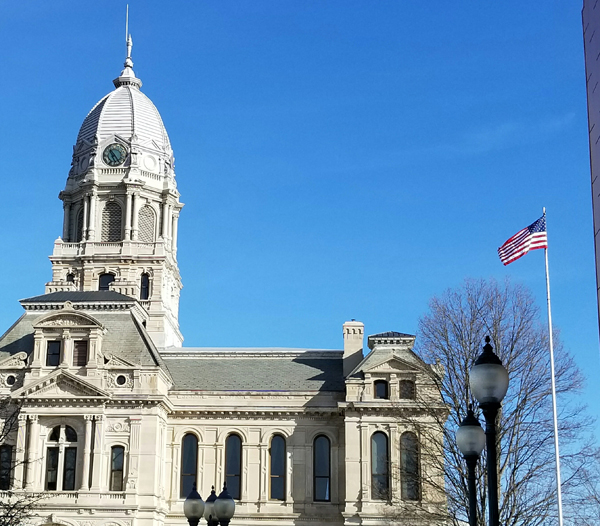TIMES UNION REPORTS – Wage increases for county employees for 2022 were approved by the Kosciusko County Council during a six-hour budget hearing Thursday, but discussion on taking the first step – advertising – toward a new local income tax was put off until Sept. 9.
The Council voted 5-1 for a 4% increase in 2022 for wages for county employees, except Sheriff’s Office employees whose wages will increase by 5%. Sheriff Kyle Dukes had expressed interest this year in a list of his employees receiving up to a 13% increase. Councilman Mike Long voted against the motion because he didn’t want to treat one county department differently from any others. Councilwoman Kimberly Cates had made a prior motion for the wage increases to be 3% for all county employees and 5% for the Sheriff’s Office, but that motion was defeated 3-3. All the county departments were told back in June to prepare their budgets with a 5% increase for their employees. Councilwoman Joni Truex was not present at Thursday’s meeting hearings.
Councilman Jon Garber had brought up the wage issue at the beginning of Thursday’s budget hearings. Councilwoman Sue Ann Mitchell said the Wage Committee wasn’t prepared to present finalized wages then, but the Council ended up discussing them further after hearing a majority of the county departments’ budgets. During the budget hearings, the County Council did approve all the 200s (supplies), 300s (services) and 400s (capital outlays) accounts presented from departments.
County Auditor Michelle Puckett told the Council they had to adopt the 2022 budget by Oct. 14.
On the wages, Mitchell said, “The unfortunate thing is, I just don’t feel like we’ve got enough information to make a really good decision, but I also know we have to make a decision. I don’t know that there’s anything differently we could have done to get to where we could make a decision.”
She said based on where the county is now, and on what the total general revenue is, the county only has an operating balance of $3.8 million.
That operating balance is the estimated amount for Dec. 31, 2022, after the 2022 estimated general fund of $26.8 million, according to provided documentation.
“I don’t want to say that is too awfully conservative on the revenue after we got the COIT (County Option Income Tax) and EDIT (Economic Development Income Tax) projects back, and we know we’re losing about $1.5 million a year on our income taxes for next year, so I did not go back once we received those estimates and refigure, but, yes, typically, we’re as conservative as we can be on our revenues because we always do our revenues low, our expenditures high so it’s a worst-case scenario, and we know that $26.7 million was all the budgets for county general what everybody requested, and that is with a 5% pay increase kind of across the board,” Puckett said.
In discussing the Wage Committee’s recommendation of a 10% wage increase for the Sheriff’s Office – which would be a half million dollars if done in one year – Cates said, “Then we have to also sustain it.” Mitchell said there’s also an officer’s longevity and pension.
Long said, “The first comment that comes to mind is: Why would you treat the Sheriff’s Department any different than anybody else in county employment?”
Puckett said the conversation on the Sheriff’s Office pay increase started “when the city of Warsaw chose to do a 13% increase to be competitive with the wages and benefits that we pay our county guys.” She said with the hiring pool and multiple units following Warsaw’s lead, that’s why Sheriff Kyle Dukes brought the wage request to the Wage Committee. “Because the city (officers were) already making more than the county deputy before that 13% increase that they received, so right now, city officers are making a little more than $100 a week above what our county deputies are making.” She said the sheriff wanted to bring the county deputies more in line with other law enforcement departments.
Long said that was all fine and good but he was struggling with treating one county department differently than any other. Cates said she was, too. With the sheriff or no officers present, Puckett talked about an officer’s jobs and hazards on the job. Long responded, “It was a choice. Nobody forced anybody into a position. It was a choice. So if you made a choice, this is what comes with that choice.” Puckett said the county treats all the departments differently based on the responsibilities and liabilities the employees have.
The Sheriff’s Office only has one opening at this time, Puckett and County Administrator Marsha McSherry determined. Councilwoman Kathleen Groninger said the Sheriff’s Office “obviously” was able to hire people at their current wages.
During discussion of the wages, Garber said they’re trying to keep the expenditures down, but they possibly needed to look at additional revenue sources, and a way to do that was with a local income tax (LIT), either Public Safety Answering Point (PSAP) or the Public Safety LIT. Cates said if they can do the Public Safety LIT, then the county “wouldn’t be up against” (the wall).
Long said, “Even with a quarter percent PSAP, we’re still looking at a very slight negative figure by the end of ’24. If things hold current and you project it on out. It’s a scary situation to be in. … With PSAP tax, I’m not one that advocates for raising taxes, but I think our revenue is not keeping up with our expenditures and we have no choice at this time. And this is a tax that has the biggest impact on every one of our taxpayers.” He said the tax would be kept local, improve quality of life and was one of the “least amounts you pay.” He said if the county was ever going to implement or raise a tax, PSAP “seems to be the best route to go.”
Garber said PSAP could only be used for dispatch, but Public Safety LIT could be used for more public safety reasons. Long said PSAP was the tax that the county would get more from, but he was told that was incorrect and the Public Safety LIT was better.
“The PSAP, a quarter percent raises $6 million,” Puckett said, but the whole $6 million would come to the county just for dispatch and not anything else. If the county approved the Public Safety LIT at a quarter percent, it would raise $6 million, but the county would receive $3.7 million with the difference being distributed to the other taxing units that have public safety.
“$3.7 (million) is better than nothing,” Cates stated.
Puckett said a half of a percent would raise about $7.5 million, “which is pretty close to offsetting the jail and the sheriff and dispatch.” She said if the LIT was adopted in 2021, collection would begin in 2022. The tax would have to be approved by Oct. 23 for the county to begin collecting it in 2022.
“And I have to say, knowing all these community budgets, if we did the half of a percent, I’m looking at some of these numbers that these communities would get, and I would imagine that they would really be appreciative to be able to use those for their police,” Cates said.
Council President Ernie Wiggins said if the Council was entertaining the new tax idea, the county has about $3.6 million in its Rainy Day Fund it hasn’t touched and about $7.5 million of American Rescue Plan money the county doesn’t know how to spend. He said the public would question that.
Long said it would be hard to sell the tax to the public, but when you look at the county’s figures, “we don’t have a choice. Nobody wants to cut budgets. We’ve kind of proven today there’s nowhere to cut the budget.”
Mitchell asked Puckett if the deadline could still be met if the Council decided at its Sept. 9 meeting to take the first step toward the tax. Puckett said yes.





